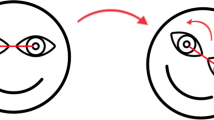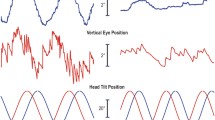Summary
Rotation of the eyes about the visual axis is known as ocular torsion. A lateral inclination (a “roll”) of the head induces ocular torsion in the opposite direction, a response known as ocular counterrolling. For six subjects, we recorded the static (head still) and dynamic (head in oscillatory roll motion) ocular torsion in normal 1 g condition and also during the microgravity and hypergravity periods of parabolic flight, using the electromagnetic scleral search coil technique. With the head still, the direction and magnitude of torsion that occured in response to microgravity and hypergravity differed substantially from one individual to another, but there was a significant difference in torsional magnitude between the microgravity and hypergravity periods, for all static head positions including the upright position. Under normal 1 g conditions, counterrolling compensated for about 16% of (voluntary) static head roll, while dynamic counterroll was much larger, up to 36% of head roll at 0.55 Hz. With increasing frequency of head oscillation between 0.33 Hz and 0.55 Hz, the gain of counter rolling increased and there was no change in the phase relationship. The gain of dynamic counterroll (in response to voluntary head rolling) was not significantly less in hypogravity, suggesting that on the ground at these frequencies the contribution of gravity and gravity receptors to this reflex is redundant: this reflex is probably driven by the semicircular canals. In some subjects, the torsional displacement in microgravity is accompanied by micro-torsional oscillatory motion.
Similar content being viewed by others
References
Baumgaiten RJ von, Thumler R (1978) A model for vestibular function in altered gravitational states. Life Sci Space Res 17:161–170
Blanks RHI, Anderson JH, Precht W (1978) Response characteristics of semicircular canal and otolith systems in cat. II. Response of trochlear motorneurons. Exp Brain Res 32:509–528
Colenbrander A (1963) The influence of G-forces on the counter rolling of the eye. Opthalmologica 146:309–313
Collewijn H, van der Mark F, Jansen TC (1975) Precise recording of human eye movements. Vision Res 15:447–450
Collewijn H, van der Steen L, Ferman L, Jansen TC (1985) Human counterroll: assessment of static and dynamic properties from electromagnetic scleral coil recordings. Exp Brain Res 59:185–196
Diamond D (1989) Simple wave analysis program. Prior Data Sciences
Diamond SG, Markham CH, Furuya N (1982) Binocular counter rolling during sustained body tilt in normal humans and in a patient with unilateral vestibular nerve section. Ann Otol 91:225–229
Diamond SG, Markham CH (1983) Ocular counterrolling as an indicator of vestibular otolith function. Neurology 33:1460–1469
Diamond SG, Markham CH (1988) Ocular torsion in upright and tilted positions during hypo and hypergravity of parabolic flight. Aviat Space Environm Med 59:1158–1162
Diamond SG, Markham CH, Money KE (1991) Prediction of space motion sickness susceptibility by disconjugate eye torsion in parabolic flight. Aviat Space Environm Med 62:201–205
Garber MA, Young LR (1991) Asymmetrical otolith signals in modified Gz environments. Abstract no 169 to 62nd Annual Scientific Meeting, Aerospace Medical Association, Cincinnati, Ohio
Howard IP (1982) Human visual orientation. John Wiley and Sons, New York, p 181
Kenyon RV (1985) A soft contact lens search coil for measuring eye movements. Vision Res 25:1629–1633
Lackner JR, Graybiel A, Johnson WH, Money KE (1987) Asymmetric otolith function and increased susceptibility to motion sickness during exposure to variations in gravitoinertial acceleration level. Aviat Space Environm Med 58:652–657
Miller II EF, Graybiel A, Kellogg RS (1966) Otolith organ activity within earth standard, one-half atandard and zero gravity environments. Aerospace Med 37:399–403
Miller II EF, Graybiel A (1968) Effect of drugs on ocular counter rolling. In: Third symposium on the role of the vestibular organs in space exploration. Pensacola, Florida. NASA SP-152, 341–349
Miller II EF, Graybiel A (1971) Effect of gravitoinertial force on ocular counterrolling. J Appl Physiol 31:697–700
Money KE, Kirienko NM, Watt DGD, Johnson WH, Markham CH, Diamond SG (1987) Vestibular asymmetry, space sickness and ocular torsion. In: Proceedings of Spacebound station May 6–8, 1987, Ottawa, Canada, 107–111
Remmel RS (1984) An inexpensive eye movement monitor using the scleral search coil technique. IEEE Transactions in Biomedical Engineering 17:11–14
Robinson DA (1963) A method of measuring eye movement using a scleral search coil in a magnetic field. IEEE Trans Biomed Electron BME-10:137–145
Suzuki JI, Tokumasu K, Goto K (1969) Eye movements from single utricular nerve stimulation in tha cat. Acta Otolaryngol (Stockh) 68:350–362
Takemori S, Tanaka M, Moriyama H (1989) An analysis of ocular counterrolling measured with search coils. Acta Otolaryngol (Stockh) [Suppl] 468:271–276
Tryggvason BV (1991) Acceleration levels in the KC-135. Conference Procedings Spacebound '91 sponsored by the Canadian Space Agency, Ottawa April, 1991
Author information
Authors and Affiliations
Rights and permissions
About this article
Cite this article
Cheung, B.S.K., Money, K., Howard, I. et al. Human ocular torsion during parabolic flights: an analysis with scleral search coil. Exp Brain Res 90, 180–188 (1992). https://doi.org/10.1007/BF00229270
Received:
Accepted:
Issue Date:
DOI: https://doi.org/10.1007/BF00229270




